Gladiolus liliaceus
Gladiolus liliaceus Houtt.
Family: Iridaceae
Common names: large brown-afrikaner, large brown africander, brown africander, sword lily (Eng.); ribbokblom, aandpypie, grootbruinafrikaner, kaneelaandblom, bruinaandblom, bruinaandblompypie, bruinafrikander, reebokblom (Afr.)
Introduction
The large brown-afrikaner has a remarkable ability to transform its flower colour from light brown, pinkish-red, tan, purplish, cream or greenish-yellow by day to a vibrant bluish-mauve at dusk, all while releasing a sweet, clove-like fragrance. This half-hardy winter-growing bulb is best cultivated in containers in full sunlight.

Description
Description
Gladiolus liliaceus is a perennial herb, and cormous geophyte that can grow to a height of 300–800 mm. The corms are globose, typically 12–18 mm in diameter, with woody to leathery tunics that split into clawed segments at the bottom. The stem is erect or inclined and unbranched. The leaves are linear with thickened margins and a raised midrib. They can be (1.5–)2.0–4.0(–6.0) mm wide. The flowers are arranged in spikes with 1–4(6) flowers and have a long tubular shape. They come in various colours, like light brown, dull pinkish red, tan, purplish or cream-coloured or greenish yellow, and may turn bluish-mauve in the evening. The flowers emit a sweet clove-like scent in the evening. The flowering time at lower elevations is in early spring, from late August to mid-September, with late blooming around early summer, in November and December at higher elevations. After flowering, it produces oblong-ellipsoid capsules, 30–50 mm long, containing ovate, broadly and evenly winged seeds, 4–5 x 3.0–3.5 mm.
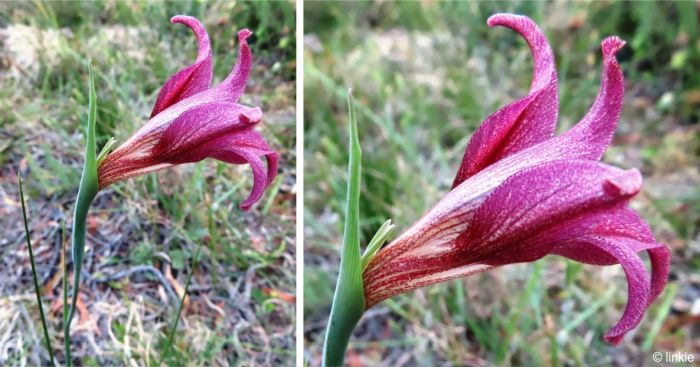
Gladiolus liliaceus can be differentiated from the other species in the genus using several distinguishing features. These include its linear lower leaf with prominently thickened and raised margins and midrib, as well as its relatively large trumpet-shaped flowers with upper tepals and perianth tube measuring 37–45 mm and 45–53 mm long, respectively. Although G. liliaceus is closely related to G. hyalinus Jacq., they differ notably in flower size, with the latter exhibiting smaller flowers, with tepals measuring between 22–30 mm long and a perianth tube ranging from 25–36 mm in length.
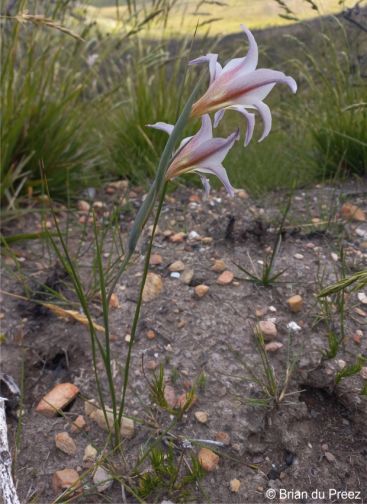
Conservation Status
Status
According to the Red List of South African Plants G. liliaceus is classified as Least Concern (LC).
Distribution and habitat
Distribution description
Gladiolus liliaceus is native to South Africa and is restricted to winter-rainfall regions in the Eastern Cape and Western Cape provinces. The species is distributed from the Cederberg to Bredasdorp and along the lower slopes of the coastal mountains to Gqeberha. It grows in heavy clay soil in lowland renosterveld.
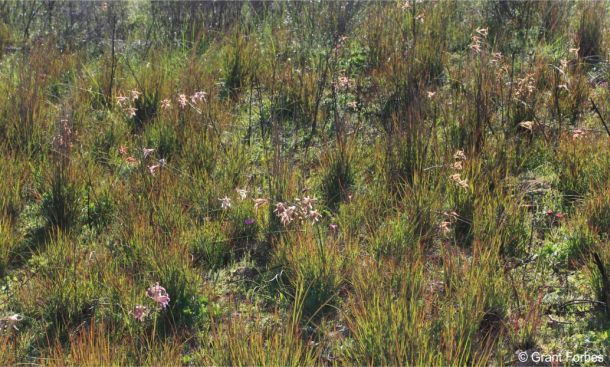
Derivation of name and historical aspects
History
The genus Gladiolus belongs to the Iridaceae, a family with more than 60 genera worldwide. Gladiolus is the largest genus in the Iridaceae with approximately 255 species. Gladiolus species are widely distributed across various southern African countries such as South Africa, Namibia, Botswana, Zimbabwe, Mozambique, Lesotho, and Eswatini (formerly Swaziland). Gladiolus can also be found in other parts of Africa, and in Europe, Asia, North America, and South America. Specific countries where Gladiolus species are distributed include Ethiopia, Kenya, Tanzania, Madagascar, Spain, Portugal, Italy, Greece, Turkey, Iran, India, China, Japan, the United States, France, Germany, Australia and Mexico, United Kingdom of Great Britain and Northern Ireland, Democratic Republic of the Congo and Switzerland.
The genus name Gladiolus was established by Linnaeus in his Species Plantarum (1753) and Genera Plantarum 36 (1754). Gladiolus gets its name from the Latin word gladius, meaning ’sword’, referring to its sword-shaped leaves. Gladiolus liliaceus was first identified and documented by Maarten Houttuyn in 1780, who observed that it did not belong to any of the named species. He chose the name liliaceus because he thought that the flowers strongly resembled those of a lily, although displaying typical Gladiolus traits, such as having one lobe that is shorter and broader than the others. The specific epithet, liliaceus means ‘like a lily’, and is derived from the Latin word lilium, which means ‘lily’. A specimen matching Houttuyn’s description is housed in Burman’s collection at the Delessert Herbarium in Geneva, believed to be the original type specimen.
Ecology
Ecology
Gladiolus liliaceus can change its flower colour at sunset to bluish-mauve whilst releasing a strong sweetly clove-like scent to attract its pollinators, owlet moths (Family Noctuidae) and hawk moths (Family Sphingidae).
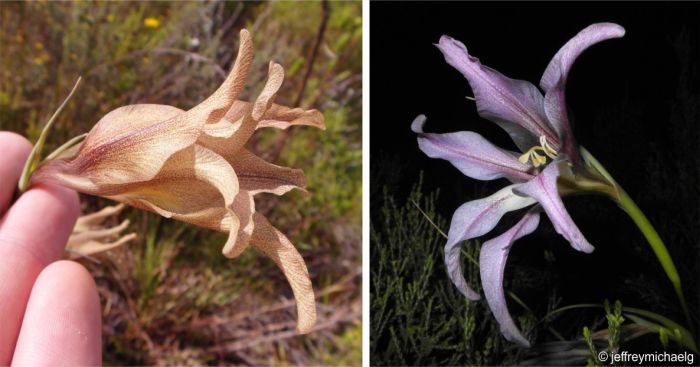
Uses
Use
Gladiolus liliaceus has no known traditional or economic uses. However, it has ornamental value and it can be cultivated for its beautiful flowers, best in containers or in water-wise fynbos or renostervel gardens where it will be dry during summer. It can also be used in floral arrangements and cut flower displays.
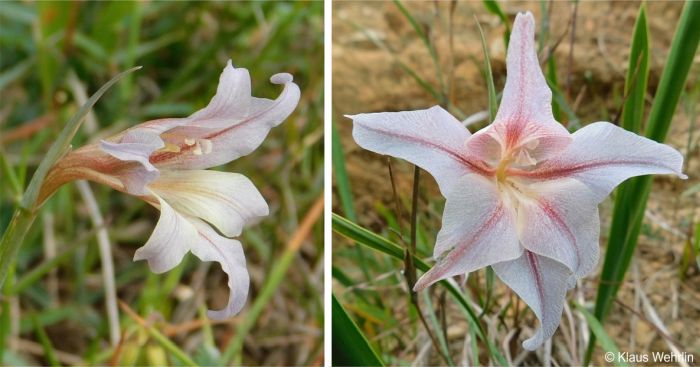
Growing Gladiolus liliaceus
Grow
Gladiolus liliaceus flourishes on well-drained soil with full sun exposure in a frost-free environment. Propagate G. liliaceus using the corms or the cormlets in autumn. Plant G. liliaceus in soil composed of 50% loam and 50% sand to ensure good drainage. Ensure that the soil acidity is between 6.0 to 6.5. Poor drainage could lead to the corms rotting. Plant G. liliaceus in either containers and/or in the ground. Ensure that the plant is not exposed to temperatures below 0⁰C. Plant the corms about 7 to 10 cm deep and 15 cm apart in soil that has been loosened to a depth of 20 cm. Take note that the depth at which the corm should be planted is dependent on the size of the corm, usually two to three times the height of the corm. Water the plant moderately every seven to ten days. Do not water the plant during the summer season as the plant is dormant (non-active) and the corms may rot. The flowering time of this species varies based on its location and altitude, with lower elevations typically experiencing earlier blooming. Flowers can be seen from early spring to misdummer (late August to December).
The growth of G. liliaceus can be affected by pests such as mealy bugs and aphids, and fungi (Fusarium). Infestation by mealy bugs can be identified by oily white deposits between the corm tunics and on the undersides of the leaf bases. Various methods can be employed to treat plants affected by mealy bugs, including the use of insecticides and manual removal followed by chemical application. The insecticide, Imidacloprid should be applied directly onto the soil and this treatment remains effective for up to a year. Hand removal involves squashing mealy bugs against the corm and wiping them away using a solution of equal parts of methylated spirits and water applied with cotton wool. It is important to rotate or change insecticides to prevent the development of resistance. Aphids are found in developing flower buds and on the foliage. If left untreated, their presence can lead to early yellowing of leaves and flower deformities. Aphids can be removed by spraying the affected areas with a solution containing 5 ml of liquid soap per liter of water. The Fusarium dry rot infection can be spotted by the presence of reddish-brown lesions on the corms. The infected corms can be treated by dusting the corm with Flowers of Sulphur powder (fungicide).
References
- Bredenkamp, C.L. & Magwaza, Z.L. 2019. Iridaceae. In: Bredenkamp, C.L. (ed.), A Flora of the Eastern Cape Province, Strelitzia 41(3): 1821–1882. South African National Biodiversity Institute, Pretoria.
- Du Preez, B. 2021-Dec. Observation of Gladiolus liliaceus, Overberg, Western Cape. iNaturalist. Online. https://www.inaturalist.org/observations/102615194.
- Forbes, G. 2022- Sep. Observation of Gladiolus liliaceus, Overberg, Western Cape. iNaturalist. Online. https://www.inaturalist.org/observations/134774648.
- Global Biodiversity Information Facility. Gladiolus Tourn. ex L. GBIF Occurrence. https://doi.org/10.15468/dl.hrr6b5. Accessed 08/04/2024.
- Goldblatt, P. & Manning, J.C. 2020. Iridaceae of southern Africa. Strelitzia 42. South African National Biodiversity Institute, Pretoria.
- Goldblatt, P. & Manning, J.C. 2002. Evidence for moth and butterfly pollination in Gladiolus (Iridaceae-Crocoideae). Annals of the Missouri Botanical Garden 89:110–124.
- jeffreymichaelg. 2014-Nov. Observation of Gladiolus liliaceus, Helderberg, Western Cape. iNaturalist. Online. https://www.inaturalist.org/observations/11089041.
- Lewis, G.J., Obermeyer, A.A. & Barnard, T.T. 1972. Gladiolus: a revision of the South African species. Journal of South African Botany Suppl. 10
- linkie. 2021-Oct. Observation of Gladiolus liliaceus, Vlooikraal, Western Cape. iNaturalist. Online. https://www.inaturalist.org/observations/98780051.
- Linnaeus, C. 1753. Species plantarum. 1st edition. Salvius, Stockholm.
- Linnaeus, C. 1754. Genera plantarum eorumque characteres naturales secundum numerum, figuram, situm, et proportionem omnium fructificationis partium (editio quinta ab auctore reformata et aucta). Stockholm: Salvius.
- Manning, J. & Goldblatt, P. 2012. Plants of the Greater Cape Floristic Region 1: the Core Cape Flora. Strelitzia 29. South African National Biodiversity Institute, Pretoria.
- Raimondo, D., Von Staden, L., Foden, W., Victor, J.E., Helme, N.A., Turner, R.C., Kamundi, D.A. & Manyama, P.A. (eds) 2009. Red list of South African plants. Strelitzia 25. South African National Biodiversity Institute, Pretoria.
- Ross, F. 2021. A grandeur of gladioli. Veld & Flora 107(3):10–15.
- The International Plant Names Index. The Royal Botanic Gardens, Kew, Harvard University Herbaria & Libraries and Australian National Herbarium. http://www.ipni.org. Accessed 11/03/ 2024.
- The World Flora Online. Gladiolus liliaceus Houtt. http://www.worldfloraonline.org/taxon/wfo-0000790005. Accessed 18/03/2024.
- Wehrlin, K. 2017-Sep. Observation of Gladiolus liliaceus, Greyton, Western Cape. iNaturalist. Online. https://www.inaturalist.org/observations/8558923.
Credits
Ramafalo Dikeledi
National Herbarium, Pretoria
October 2024
Acknowledgements: the author thanks Natasha Lombard for reviewing the article, and jeffreymichaelg, linkie, klauswehrlin (Klaus Wehrlin), wendy_june (Wendy June Norris), grantforbes (Grant Forbes) and mr_fab (Brian du Preez) for making their images available via iNaturalist.
Plant Attributes:
Plant Type: Bulb
SA Distribution: Eastern Cape, Western Cape
Soil type: Sandy, Loam
Flowering season: Spring, Early Summer
PH: Acid
Flower colour: Brown, Purple, Red, Pink, Cream, Yellow, Mauve/Lilac
Aspect: Full Sun
Gardening skill: Average
Special Features:
Horticultural zones









Rate this article
Article well written and informative
Rate this plant
Is this an interesting plant?
Login to add your Comment
Back to topNot registered yet? Click here to register.